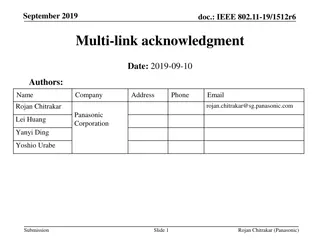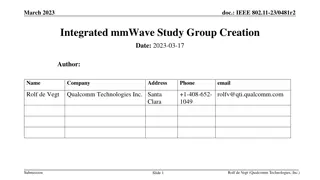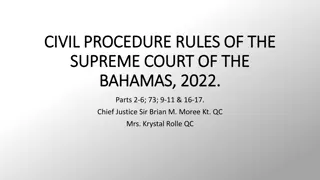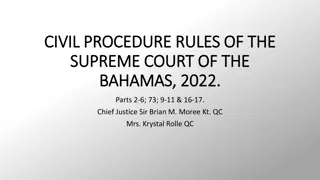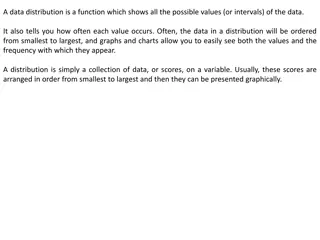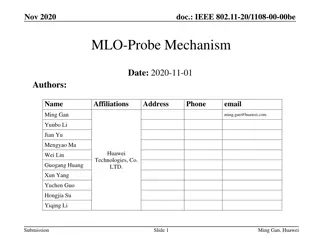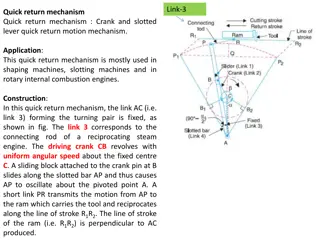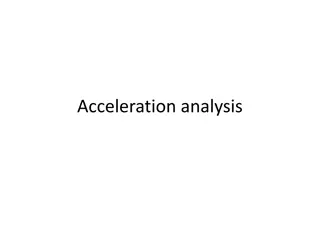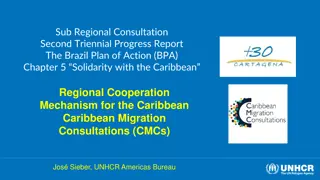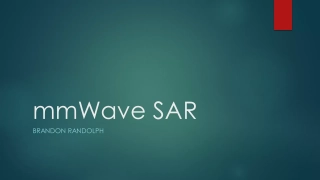Acknowledgment Mechanism for mmWave Distribution Networks
This document discusses the proposal for an Acknowledgment (Ack) and Block Acknowledgment (BA) mechanism for Time Division Duplex (TDD) Channel Access in mmWave Distribution Networks. The requirements for sending Ack/BA in different slot structures to accommodate various traffic profiles are outlined. The mechanism aims to optimize the existing specifications for efficient transmission and reception of acknowledgments in high-frequency distribution networks.
Uploaded on Sep 12, 2024 | 1 Views
Download Presentation

Please find below an Image/Link to download the presentation.
The content on the website is provided AS IS for your information and personal use only. It may not be sold, licensed, or shared on other websites without obtaining consent from the author. Download presentation by click this link. If you encounter any issues during the download, it is possible that the publisher has removed the file from their server.
E N D
Presentation Transcript
Nov 2017 doc.: IEEE 802.11-17/1647r0 Ack/BA for mmWave Distribution Networks Authors: Name Company Address Phone Email George Cherian Qualcomm gcherian@qti.qualcomm.com Lochan Verma Qualcomm lverma@qti.qualcomm.com Solomon Trainin Qualcomm strainin@qti.qualcomm.com Carlos Cordeiro Intel carlos.cordeiro@intel.com Carlos Aldana Intel carlos.h.aldana@intel.com Oren Kedem Intel oren.kedem@intel.com SungJin Park LGE allean.park@lge.com Submission Slide 1 Qualcomm
Nov 2017 doc.: IEEE 802.11-17/1647r0 Introduction TDD Channel Access in mmWave Distribution Network discussed in [1] Need for scheduling of Ack/BA in mmWave Distribution Network discussed in [2] A-BFT ATI CBAP1 SP1 SP with TD channel access BTI CBAP2 Terminology Example values TDD-interval 2 TDD-interval-n TDD-interval 1 TDD-slot 66us TDD-interval 400us SP with TDD channel access Bandwidth grant (25.6ms) TDD- slot5 TDD- slot3 TDD- slot4 TDD- slot1 TDD- slot2 TDD- slot0 E.g., for TX E.g., for RX Access assignment to STAs (CNs, DNs) This contribution proposes Ack/BA mechanism for TDD Channel Access Submission Slide 2 Qualcomm
Nov 2017 doc.: IEEE 802.11-17/1647r0 Requirements for sending Ack/BA - I 1. Minimize the existing spec Would like to use the Immediate Ack policy with the extensions identified in this contribution 2. A TDD-slot structure that consists of different slot-sizes to accommodate different traffic TDD-Slot structure should be flexible to address different traffic profiles Two extreme examples are (i) unidirectional traffic, and (ii) bi-directional traffic with equal volume on both directions In the case of unidirectional traffic, traffic on reverse direction is primarily acknowledgements (TCP Ack, and block-acks). So, having short slots allocated for reverse direction is preferred for efficiency reasons. Since the slot-structure is expected to be semi-static, a slot-structure that consists of short-slots should be usable in a bi-directional traffic as well. Since the small slot may not be able to carry a full data-MPDU, the scheduler should be able to send Block-Ack in a small slots This creates a situation, where a longer slot and a shorter slot is allocated to the same node, and the block-ack is sent in the shorter slot TDD-interval 0 TX Polarity RX Polarity B->A A->D A->C C->A B->A A->B TDD- slot 5 TDD-slot 4 TDD- slot 2 TDD-slot 1 TDD-slot 3 TDD-slot 0 Ack sent at this slot Submission Slide 3 Qualcomm
Nov 2017 doc.: IEEE 802.11-17/1647r0 Requirements for sending Ack/BA - II 3. Acknowledgement may be sent in a reverse TDD-slot that is in a different TDD Interval Scheduler may not be able to fit acknowledgement for different nodes in the same TDD- Interval Ack/BA for certain nodes may be sent at a later slot TDD-Interval 0 TDD-Interval 1 TX Polarity RX Polarity B->A D->A A->D A->C C->A B->A A->B TDD-slot t11 TDD- slot 5 TDD-slot 4 TDD- slot 2 TDD-slot 1 TDD-slot 3 TDD-slot 0 Ack sent at this slot (different TDD-Interval) Submission Slide 4 Qualcomm
Nov 2017 doc.: IEEE 802.11-17/1647r0 Proposal summary Define a two category of TDD-Slots Data-only TDD-Slots : TDD-Slots that are permitted to carry only data frames Basic TDD-Slots : TDD-Slots that are permitted to carry any frame including Control frames and Management frames. The goal would be to prioritize the Control & Management frames if the TDD-Slot were to be shared with data frames Ack/BA are sent at the next scheduled reverse TDD-Slot that permits the transmission of Ack/BA, after the transmission of Data frame So, Ack Timeout will be a variable value During the Basic slot, prioritize Ack/BA over Data/Management Both eliciting node and responding node knows the next scheduled reverse TDD- Slot that permits the transmission of Ack/BA from the TDD Slot Schedule element . No need to explicitly signal the time-out value Submission Slide 5 Qualcomm
Nov 2017 doc.: IEEE 802.11-17/1647r0 What about other immediate control responses? RTS/DMG CTS/DMG DTS Delayed response doesn t help with the intended protection Will not be able to silence legacy devices due to CTSTimeout Grant/Grant Ack Not needed for TDD-Slot mode, since schedule is transmitted through Announce frame Response frame in ATI Not relevant for TDD-Slot mode Submission Slide 6 Qualcomm
Nov 2017 doc.: IEEE 802.11-17/1647r0 Standards changes (high level) Add a classification to each TDD-Slots Add a new field called slot-category in the TDD Slot Schedule element format with the following values: Basic TDD slot: A slot that has no restriction on the type of frames Data-only TDD slots: A slot that permits only QoS data frames The above field indicates what type of frames can be carried in the assigned slot Change the Ack Timeout rule Current spec: After transmitting an MPDU that requires an Ack or BlockAck frame as a response (see Annex G), the STA shall wait for an AckTimeout interval, with a value of aSIFSTime + aSlotTime + aRxPHYStartDelay, starting at the PHY-TXEND.confirm primitive New rule for TDD Ack/BA (not the exact normative text): After transmitting an MPDU that requires an Ack or BlockAck frame as a response, the STA shall wait for an AckTimeout interval, with a value of duration from the beginning of the slot that carried the MPDU to the end of the first available basic slot on the reverse direction, starting at the PHY- TXEND.confirm primitive Do we need to add aSIFSTime + aSlotTime + aRxPHYStartDelay? Changes on sending the Ack/BA (not exact normative text) A recipient of a QoS Data frame, or Management frame that solicits immediate acknowledgement shall respond with BlockAck/Ack frame in first reverse slot that permits Ack/BlockAck transmission (where the slot category is set to Basic slot). Submission Slide 7 Qualcomm
Nov 2017 doc.: IEEE 802.11-17/1647r0 Standards change summary (contd) 10.36.7 - 10.36.9 : Dynamic allocation/truncation/extension of Service Period Prohibit Poll frame Backoff procedure No exponential backoff when a transmission fails. Submission Slide 8 Qualcomm
Nov 2017 doc.: IEEE 802.11-17/1647r0 Reference 1. IEEE 802.11-17/1323r2, Scheduling for mmWave Distribution Networks 2. IEEE 802.11-17/1065r1, Ack and Block Ack Handling for mmWave Distribution Network Use Case Submission Slide 9 Qualcomm
Sept 2017 doc.: IEEE 802.11-17/1647r0 SP#1 Do you agree to add a new field called slot-category in the TDD Slot Schedule element format with the following values: Basic TDD slot: A slot that has no restriction on the type of frames Data-only TDD slots: A slot that permits only QoS data frames The above field indicates what type of frames can be carried in the assigned slot Submission Slide 10 Qualcomm
Sept 2017 doc.: IEEE 802.11-17/1647r0 SP#2 Do you agree to define ACK/BA transmission rule when SP with TDD channel access is used as follows (not normative text below) A recipient of a QoS Data frame, or Management frame that solicits immediate acknowledgement shall respond with BlockAck/Ack frame in first reverse slot that permits Ack/BlockAck transmission (where the slot category is set to Basic slot). Submission Slide 11 Qualcomm
Sept 2017 doc.: IEEE 802.11-17/1647r0 SP#3 Do you agree to define AckTimeout value when SP with TDD channel access is used as follows (not the exact normative text) After transmitting an MPDU that requires an Ack or BlockAck frame as a response, the STA shall wait for an AckTimeout interval, with a value of duration from the beginning of the slot that carried the MPDU to the end of the first available basic slot on the reverse direction, starting at the PHY-TXEND.confirm primitive Submission Slide 12 Qualcomm




